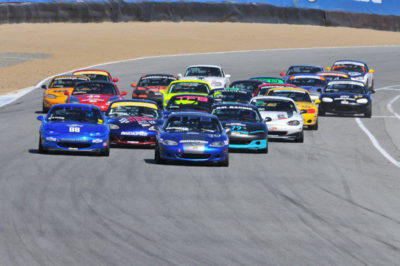Mazdas comprise approximately 57 percent of all of the cars competing in grassroots racing across the country. The pinnacle of all grassroots racing takes place this week at the SCCA National Championship Runoffs at Daytona. Tom Long, one of Mazda’s factory Prototype drivers, is there, coaching and helping Mazda racers. We get a first-hand report from Tom about preparing like a professional for the Runoffs. (And good luck to all Mazda competitors!)
Thanks to having the incredible opportunity to be a factory driver for Mazda, I just wrapped up the IMSA Tudor United SportsCar race at Circuit of the Americas, driving at a world-class facility in our SKYACTIV Prototype. Next weekend, we’ll be running in the world-renowned Petit Le Mans at Road Atlanta, truly a bucket list event.
The weekend in between is busy for me with the SCCA Runoffs, which are being held at Daytona International Speedway for the first time since 1969. Running a pro event as a factory driver and then heading straight to the National Championships at the club racing level really highlights the differences between the two, although the goals are very similar.
Even though these two levels of racing can be very different, there are very valuable lessons and skills that you learn along the way. These skills are ideal for racers who are trying to develop their career from the grassroots racing level into pro racing, and the Runoffs is a great place to sharpen those skills even more because you’re competing against the best in the country in your class.
There are a number of great takeaways from championship-level club racing that will give you an edge when moving into the pro ranks:
Focus under pressure
In pro racing, even though it might be a 10- or 12-race series, each race is critically important. That pressure that you feel in pro racing can be way more intense than at the club level, even down to the amount of fans and distractions at an event. The Runoffs is very similar to that: it’s the most competitors you’re going to face all season, there’s a lot going on throughout the week that can be very distracting, and when it comes down to race time, you need to be the most focused you’ve been all year to get the best results.
Adaptability and efficiency at new tracks
With the SCCA changing the Runoffs location every year now, you may find yourself heading to a track you have never visited. If you’re competing at many tracks during a season, eventually you’ll find yourself at a new track. Even veteran racers encounter tracks they haven’t been to before, such as when a series goes to a new street circuit or a brand-new track.
You need to know what to focus on when you’re developing the car for an unfamiliar track, whether it’s high speed or tight and technical. Learning to understand a track in a short amount of time requires you to do your homework. This includes things like simulator practice, studying track maps and notes, watching videos, track walks, and doing other information gathering even before you get there.
Engineering and strategy skills
Engineering skills are closely related to that last point. At the club level, you won’t have a whole engineering staff that will figure out the answers for you, so you have to be able to think for yourself and decide what areas of the circuit give you the best potential for gaining time. For example, at Daytona, the bus stop chicane ultimately is what keeps the track from being flat out from the infield all the way around to the start/finish line, so having a car that works well through the bus stop is critical for a good lap there. Obviously, aerodynamic efficiency is a must for all of the high-speed banking. At the pro level, you might have a crew chief and several engineers who will look at the data and determine where the areas of improvement are, but as a driver providing feedback, you’ve got to be able to think about what’s keeping you from going faster in particular areas of the circuit, and you need the ability to prioritize those areas.
Maximizing limited track time
At the pro level, the amount of track time you get at each event is minimal, and every minute on track is extremely important because of that. With all of the support series that run at an event, you might have only an hour or two of practice before it’s time to qualify. As a driver, you need to be on your “A” game right away.
The Runoffs is great practice for that because you’ll only get 30 minutes on track per day. When that is the case, you’ve got to have your test plan together so you know exactly what you’re working on – whether it’s a driving or setup aspect, or both – and be able to recognize how to continue improving every time you go out.
I look forward to seeing everyone at the Runoffs! I’m here providing coaching on behalf of Mazda Motorsports and will be happy to help with any tips or advice throughout the week. Good luck!


 ACCESSIBILITY
ACCESSIBILITY